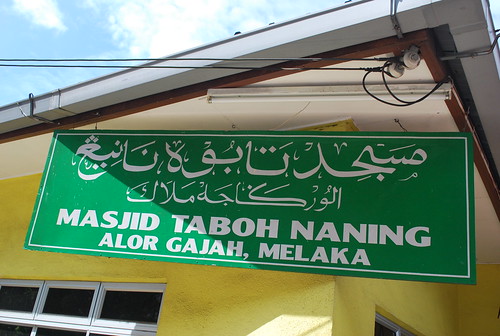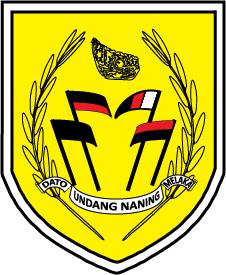
The tribal name Minangkabau may be based on a myth that tells of the tribe's victory in a fight between two water buffaloes. As victors, the tribe became known as the Minang (winning) kabau (water buffalo).
A unique aspect of Minangkabau culture is that their society is matrilineal. This means that they recognize descent through the female line. They are, in fact, the largest people group in the world to continue this practice. The strength of their culture is that they have remained matrilineal while embracing Islam.
Their native language, Minangkabau, is distinct, yet related to the language of the Malay and similar to Indonesian.
Over the years, the Minangkabau have migrated to cities and towns in pursuit of business or labor. Today, they are mainly occupied in business and trade, and are renowned among scholars and throughout Western Malaysia for their prominence in business. In fact, they are one of the few ethnic groups that can compete successfully with the Chinese.
The Minangkabau who live in villages have become highly skilled in several home industries. Their businesses include weaving, blacksmithing, and carving. Those who live scattered throughout the countryside are primarily wet rice farmers.
The Minangkabau are the world's largest matrilineal group. Properties and family names are passed down through the women. Marriages are usually arranged by a representative of the family. Young married couples usually live with the wife's mother or another of the wife's relatives.
The woman is expected to manage both a career and the home. Land is owned collectively by the older women, but decisions regarding land usage are made by a consensus, with an elected male elder presiding. Many Minangkabau men leave home seeking wealth and respect. Perhaps this explains why divorce is a very common occurrence.
The Minangkabau possess a wide variety of cultural abilities. Worldwide attention has been given to their distinctive styles of art, music, architecture, poetry, and literature. They also enjoy times of celebration, such as holidays, Islamic pilgrimages, weddings, and house dedications.
Most Minangkabau are Shafite Muslims. They are among Malaysia's most devout Muslims, with many holding important positions of leadership. Religious services are well-attended, and the 'five pillars of Islam' are diligently practiced.
It is very interesting that mythology concerning Minangkabau origin includes the story of a worldwide flood and three brothers who survived on a boat.
The Minangkabau take great pride in their ancestry, claiming to have descended from Alexander the Great. These gifted people have impacted Malaysia in areas of government, the arts, and various professions. Unfortunately, their success has given them a false sense of security, and they appear to have no need for the Gospel. However, changes in familial traditions and increased migration to the cities may provide inroads for the Gospel into this tightly knit group.
The Minangkabau people migrated across the Straits of Melaka from Sumatra centuries ago and their traditional houses are distinguished by sweeping roof peaks shaped like buffalo horns.
The Minangkabau people of Melaka still practise the matrilineal social system known as the "Adat Perpatih", where the women are the head of the household, making the state the only one to adhere to such social norms.
When the people of Minangkabau, Sumatra, migrated to Melaka in the 12th century, they brought with them not just their kith and kin but their entire system of beliefs and governance.
According to the Minangkabau tradition, clan names, titles, land and property passed through the female lineage instead of the male line.
When they landed in Melaka, the Minangkabau accepted the Melaka sultan as their ruler and enjoyed the sultan’s protection.
However, when Melaka was invaded by the Portuguese in 1511, the Minangkabau shifted allegiance to the Johor sultan as they did not want to come under European rule.
By the 18th century, however, they began governing themselves – out of necessity more than anything, as Johor was then embroiled in internal strife and could no longer offer them protection – and a leader from Minangkabau was selected.
The History of the Naning War in Malaysia, 1831-1832
Also known as the ‘Little War’, the Naning War was an important event in Malaysian history, despite the fact that scholars dismiss it as a “more expansive drama”. The war expressed traditional modes of power-broking and opposition, as well as anticipated later political developments in Malaya. From the wider perspective of imperial history, this important but neglected episode of British expansion in the East.
The origins of the Naning War can be directed at the British incursions to the archipelago allowing the territorial acquisition of Penang (1786), Bencoolen and Java (1811), Singapore (1819) and Melaka (1824); but these had ripple effects throughout the region.
Naning was a small inland state of 240 square miles situated ten miles north of Melaka town. Between August 1831 and July 1832, the English East India Company was at war with this state, not so much because of what it worth already, but because of its potential worth – “matters concerning land revenue and jurisdiction were bound up with issues such as agricultural and commercial potential and access to its labour”.
The ‘ultimate cause’ of the Naning War was its status in the eyes of the East India Company – they saw the state as a vassal province whose ruler owed his appointment and authority to them. Indeed, there seems to be evidence for this in the Dutch treaty of 1641 and the British one of 1801. However, the ruler, the Malay people and Minangkabau all saw different.
The ruler of Naning, known by his title of Penghulu Raja Mera, had agreed with the Dutch and then later the British, that he would pay a yearly tenth on his rice crops for acknowledgment of his title, though the British continued the practice of accepting instead a token tribute of rice and fowls. “In 1807, however, in consideration of his role as a mere functionary of the Company, they stripped the penghulu of his right to inflict the death penalty and required him to send capital cases to Melaka for trial”.
In March 1827, the Company sent William Lewis, deputy Resident Councillor of Melaka, to Naning to access the situation. Lewis realised the area’s rich economic prospectives and was horrified at the penghulu's exactions, and so told the Company to enforce their full rights in Naning.
“The war was protracted because Naning was the epicentre of a wider power struggle in the interior. In 1758, the Dutch had signed a treaty with Johor placing the inland states of Sungei Ujong, Rembau, Johol and Naning under Dutch protection.
By 1831 the office of Yang di-pertuan Besar was contested. When the new candidate, Raja Labu, came from Sumatra with the usual credentials in 1828, he was backed by the Dato Klana, chief of Sungei Ujong and most senior of the four undang-undang ('lawgivers'), but opposed by Raja Ali of Rembau, an ambitious half-Bugis nephew of Sultan Ibrahim, ruler of the predominantly Bugis state of Selangor.
Ali had exploited family quarrels to seize power in Rembau and now felt threatened by the election of Labu, whose wife was Ali's aunt and one of his fiercest foes. Labu was driven to seek political asylum at Melaka, where he was living in 1831 under the title Yang di-pertuan Besar of Sri Menanti”.
It was the British secret meetings with Rembau, Naning’s ally, that allowed them to defeat Do Syed and Nanning. The state was incorporated into Melaka territory and redefined administratively.
The Naning War may be passed over as a minor dispute in Malaysian history, but on closer examination, we can see its true worth. It was a series of interlocking crises which gripped the Malay world and ultimately, the English East India Company.
Taboh Naning

Naning Flag
Taboh Naning is the only one province outside Negeri Sembilan that still practice the ‘Adat Perpatih’. There are still headman who control the culture and custom of Pembesar Waris and so on such as the most famous Datuk Naning, Dato’ Dol Said. 4 major tribes (suku) in the Naning province called the Suku Anak Melaka (Meruar), Suku Mungkar (Utar-Utar), Suku Semelenggang (Ular Ular) and Suku Tiga Batu (Tonggo).
.jpg)
Suku Anak Melaka Flag
.jpg)
Suku Mungkar Flag
.jpg)
Suku Semelenggang Flag
.jpg)
Suku Tiga Batu Flag
Taboh is one of the musical instrument also known as ‘gendang’. This taboh is used in many mosque in Melaka before the ‘Azan’ in order to inform to people its time to pray to the god.

Taboh

Naning is a type of spiritual hornet (penyengat) that used by Dato’ Dol Said to attack the British in Naning War but then those hornet dissapeared after the British army poured the pigs blood to the hornet’s nest with the help from Rembau people who were disloyal to Dato’ Dol Said and Naning State.

List of Datuk Naning
1. Megat Alam Melintang 1641-
2. Megat Junjungan Limau
3. Juara Megat
4. Kokah Bernama Zohri
5. Gahang Berbulu
6. Selamat Idris
7. Timbo
8. Anjak
9. Dol Said bin Omar 1799 - 1849
10. Idas 1849 - 1870
11. Mohd Salleh @ Aghap bin Rahim 1870 - 1900
12. Ranting 1900-
13. Hassan 1916
14. Omar 1918-
15. Arshad 1923 - 1932
16. Osman bin Kering 1932-
17. Cek Lah bin Mohd Sab 1949
18. Dato' Mohd Shah bin Mohd Said al-haj 1951 - 2006
19. Dato' Abdul Latif Hashim 2006 - current

Orang Kaya Seri Raja Me'rah YAM Dato' Abdul Latif Hashim and Toh Puan Sahzizan Deris
Dato' Dol Said's Mausoleum

Dato’ Dol Said, the ninth ruler of Naning who defiantly opposed the imposition of tax on the district by the British. He valiantly resisted British forces on Naning, deploying his troop with outstanding display of military ingenuity that outsmarted the invading forces on two campaigns.
The Naning War, waged in 1834, made Dol Said a hero of exceptional valor that earned him a permanent place in the history of Melaka. He was buried here at Taboh Naning, about 32km from Melaka city.
Cuisine
Traditional Melaka Minang food is hot and spicy, as one of the ingredients used is the chili padi, the hottest of chillies. Popular dishes include rendang, (pieces of beef cooked in coconut milk and chillies). One should experience the unique Minangkabau style of cooking, which sees generous portions of 'chili padi' (small & extremely hot chilies) being used. Try the "Masak Lemak Chili Padi - fish, meat, or vegetables cooked in coconut milk blended with turmeric and ground chili padi.
Traditional Melaka Minang food is hot and spicy, as one of the ingredients used is the chili padi, the hottest of chillies. Popular dishes include rendang, (pieces of beef cooked in coconut milk and chillies). One should experience the unique Minangkabau style of cooking, which sees generous portions of 'chili padi' (small & extremely hot chilies) being used. Try the "Masak Lemak Chili Padi - fish, meat, or vegetables cooked in coconut milk blended with turmeric and ground chili padi.
Another Minang specialty is "Lemang", glutinous rice cooked in coconut milk in a bamboo stem over an open fire. This is normally served with Rendang, a deliciously thick, dry meat curry.

Lemang Minang

Rendang Maman
